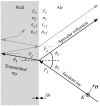Indoor Multipath Assisted Angle of Arrival Localization
- PMID: 29099055
- PMCID: PMC5713621
- DOI: 10.3390/s17112522
Indoor Multipath Assisted Angle of Arrival Localization
Abstract
Indoor radio frequency positioning systems enable a broad range of location aware applications. However, the localization accuracy is often impaired by Non-Line-Of-Sight (NLOS) connections and indoor multipath effects. An interesting evolution in widely deployed communication systems is the transition to multi-antenna devices with beamforming capabilities. These properties form an opportunity for localization methods based on Angle of Arrival (AoA) estimation. This work investigates how multipath propagation can be exploited to enhance the accuracy of AoA localization systems. The presented multipath assisted method resembles a fingerprinting approach, matching an AoA measurement vector to a set of reference vectors. However, reference data is not generated by labor intensive site surveying. Instead, a ray tracer is used, relying on a-priori known floor plan information. The resulting algorithm requires only one fixed receiving antenna array to determine the position of a mobile transmitter in a room. The approach is experimentally evaluated in LOS and NLOS conditions, providing insights in the accuracy and robustness. The measurements are performed in various indoor environments with different hardware configurations. This leads to the conclusion that the proposed system yields a considerable accuracy improvement over common narrowband AoA positioning methods, as well as a reduction of setup efforts in comparison to conventional fingerprinting systems.
Keywords: NLOS localization; angle of arrival (AoA); antenna arrays; indoor positioning system (IPS); multipath assisted localization.
Conflict of interest statement
The authors declare no conflict of interest.
Figures














References
-
- Klepeis N.E., Nelson W.C., Ott W.R., Robinson J.P., Tsang A.M., Switzer P., Behar J.V., Hern S.C., Engelmann W.H. The National Human Activity Pattern Survey (NHAPS): A resource for assessing exposure to environmental pollutants. J. Expo. Anal. Environ. Epidemiol. 2001;11:231–252. doi: 10.1038/sj.jea.7500165. - DOI - PubMed
-
- Li B., Rizos C. Editorial. J. Locat. Based Serv. 2014;8:1–2. doi: 10.1080/17489725.2013.870419. - DOI
-
- Kolodziej K.W., Hjelm J. Local Positioning Systems: LBS Applications and Services. CRC Press; Boca Raton, FL, USA: 2006.
-
- Kupper A. Location-Based Services: Fundamentals and Operation. John Wiley & Sons; New York, NY, USA: 2005.
-
- Liu H., Darabi H., Banerjee P., Liu J. Survey of wireless indoor positioning techniques and systems. IEEE Trans. Syst. Man Cybern. Part C Appl. Rev. 2007;37:1067–1080. doi: 10.1109/TSMCC.2007.905750. - DOI
LinkOut - more resources
Full Text Sources
Other Literature Sources

